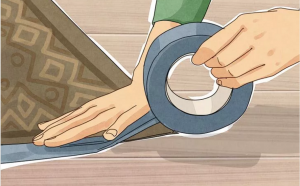Submitted by: Jackie Waters
Many parents feel sleep-deprived and overwhelmed as their babies grow into toddlers. “Baby proofing” your home can prove tricky during this stage. Your little one is walking, learning the basics of communication, testing boundaries, and learning to navigate his or her environment. If your toddler is blind or visually impaired, this creates a unique set of needs, concerns and considerations. Luckily, there are some steps you can take to ensure your child’s safety and save your own sanity.
Here’s how to modify your home for a toddler with visual impairment:
- Rearrange Furniture. Move all furniture out of walking paths and doorways, to reduce the chances of your child tripping, falling, or becoming injured. This step as a couple unexpected benefits for the rest of the household, too. Chances are, any older children and adults will also appreciate this change, as it can reduce stubbed toes and injuries. It also has the effect of making your rooms seem larger, and bringing more feng shui into your home.
- Shelves and Containers. Despite what those adorable Ikea models might tell you, never stack shelves and containers higher than shoulder height. This obscures vision for any sighted individuals in the home, and it is a major safety hazard for your child.
- Navigating the Home. If your child just has low vision rather than complete blindness, you can use color, shape and texture to draw your child’s attention to important aspects of your home. Use brightly colored and highly contrasting tape to draw attention to edges of walls, cabinets, and doors. Children who are
 blind might need tactile clues as they’ll be relying on their sense of touch more. Provide your child with a textured trailing surface, which allows your little one to run his or her fingers along the edge of a cabinet, table or other surface. This literally lets your child “feel” his or her way through a room. Over time, your child will slowly, carefully and safely learn to navigate his or her way around your home.
blind might need tactile clues as they’ll be relying on their sense of touch more. Provide your child with a textured trailing surface, which allows your little one to run his or her fingers along the edge of a cabinet, table or other surface. This literally lets your child “feel” his or her way through a room. Over time, your child will slowly, carefully and safely learn to navigate his or her way around your home. - Use Baby Gates. Some things really don’t change, regardless of whether your child is sighted or not. Baby gates can be a literal lifesaver, and must always be used if you have staircases in your home. They can also be a great option for keeping your child out of areas that are unsupervised or haven’t been properly “baby proofed.”
- Safety Latches and Locks. These devices are helpful for all toddlers, regardless of sightedness. They keep children from entering certain rooms of your house, especially rooms that are not supervised by adults. They can also keep children away from potentially dangerous areas of the home, such as staircases or swimming pools.
Although there are some special considerations for blind or visually impaired toddlers, many of the safety concerns for toddlers remain the same regardless of sightedness. You’ll want to reduce clutter in the home to the best of your ability, and make sure objects within your child’s reach are too large to be swallowed. Children should be kept away from staircases in order to prevent accidental falls and injuries. Any liquids such as water that are spilled on the floor should also be cleaned up immediately to avoid risks and safety hazards for your little one, older children and adults.
It’s healthy for all parents to worry about the safety of their children. If you’ve felt stress, exhaustion or anxiety, know that these feelings are normal with this phase of early childhood development. Remember that this phase will pass. It’s bittersweet knowing that your little one will not stay so little forever. Even when things are stressful, try to cherish the day-to-day moments. With the right resources, your child’s “terrible two’s” don’t have to be so terrible after all.





